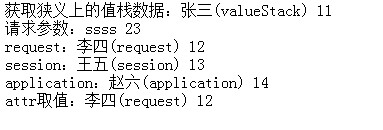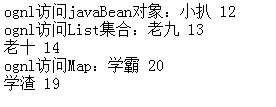(四)值栈与OGNL
所有的学习我们必须先搭建好Struts2的环境(1、导入对应的jar包,2、web.xml,3、struts.xml)
第一节:值栈简介
值栈是对应每个请求对象的一套内存数据的封装,Struts2 会给每个请求创建一个新的值栈。
值栈能够线程安全地为每个请求提供公共的数据存取服务。
第二节:OGNL 引入
OGNL 是对象图导航语言Object-Graph Navigation Language 的缩写,它是一种功能强大的表达式语言。
OGNL 访问ValueStack 数据
<s:property value=”account” />
注:这里要添加<%@taglib prefix="s" uri="/struts-tags" %>struts的标签库
OGNL 访问ActionContext 数据
访问某个范围下的数据要用#
#parameters 请求参数request.getParameter(...);
#request 请求作用域中的数据request.getAttribute(...);
#session 会话作用域中的数据session.getAttribute(...);
#application 应用程序作用域中的数据application.getAttribute(...);
#attr 按照page request session application 顺序查找值
例子:
struts.xml
1 <?xml version="1.0" encoding="UTF-8" ?>
<!DOCTYPE struts PUBLIC
"-//Apache Software Foundation//DTD Struts Configuration 2.0//EN"
"http://struts.apache.org/dtds/struts-2.0.dtd"> <struts> <package name="manage" namespace="/" extends="struts-default"> <action name="hello" class="com.wishwzp.action.HelloAction">
<result name="success" >success.jsp</result>
</action>
</package> </struts>
HelloAction.java
1 package com.wishwzp.action; import java.util.Map; import com.opensymphony.xwork2.ActionContext;
import com.opensymphony.xwork2.ActionSupport;
import com.opensymphony.xwork2.util.ValueStack; public class HelloAction extends ActionSupport{ /**
*
*/
private static final long serialVersionUID = 1L; @Override
public String execute() throws Exception {
// 获取ActionContext
ActionContext actionContext=ActionContext.getContext();
// 获取狭义上的值栈
// 值栈是用来存储数据的
ValueStack valueStack=actionContext.getValueStack();
valueStack.set("name", "张三(valueStack)");
valueStack.set("age", 11); Map<String, Object> session=actionContext.getSession();
session.put("name", "王五(session)");
session.put("age", 13); Map<String, Object> application=actionContext.getApplication();
application.put("name", "赵六(application)");
application.put("age", 14);
return SUCCESS;
}
}
success.jsp
1 <%@ page language="java" contentType="text/html; charset=UTF-8"
pageEncoding="UTF-8"%>
<%@taglib prefix="s" uri="/struts-tags" %>
<!DOCTYPE html PUBLIC "-//W3C//DTD HTML 4.01 Transitional//EN" "http://www.w3.org/TR/html4/loose.dtd">
<html>
<head>
<meta http-equiv="Content-Type" content="text/html; charset=UTF-8">
<title>Insert title here</title>
<%
request.setAttribute("name", "李四(request)");
request.setAttribute("age", "12");
%>
</head>
<body>
获取狭义上的值栈数据:<s:property value="name"/>
<s:property value="age"/><br/>
请求参数:<s:property value="#parameters.name"/>
<s:property value="#parameters.age"/><br/>
request:<s:property value="#request.name"/>
<s:property value="#request.age"/><br/>
session:<s:property value="#session.name"/>
<s:property value="#session.age"/><br/>
application:<s:property value="#application.name"/>
<s:property value="#application.age"/><br/>
attr取值:<s:property value="#attr.name"/>
<s:property value="#attr.age"/><br/>
</body>
</html>
url:http://localhost:8080/Struts2Chap04/hello?name=ssss&age=23
结果:

第三节:OGNL 访问复杂对象
1,访问javaBean 对象;
2,访问集合对象;
3,访问Map 对象;
例子:
struts.xml
1 <?xml version="1.0" encoding="UTF-8" ?>
<!DOCTYPE struts PUBLIC
"-//Apache Software Foundation//DTD Struts Configuration 2.0//EN"
"http://struts.apache.org/dtds/struts-2.0.dtd"> <struts> <package name="manage" namespace="/" extends="struts-default"> <action name="hello" class="com.wishwzp.action.HelloAction">
<result name="success" >success.jsp</result>
</action>
</package> </struts>
Student.java
1 package com.wishwzp.model; public class Student { private String name;
private int age; public Student() {
super();
// TODO Auto-generated constructor stub
}
public Student(String name, int age) {
super();
this.name = name;
this.age = age;
} public String getName() {
return name;
}
public void setName(String name) {
this.name = name;
}
public int getAge() {
return age;
}
public void setAge(int age) {
this.age = age;
} }
HelloAction.java
1 package com.wishwzp.action; import java.util.ArrayList;
import java.util.HashMap;
import java.util.List;
import java.util.Map; import com.wishwzp.model.Student;
import com.opensymphony.xwork2.ActionContext;
import com.opensymphony.xwork2.ActionSupport;
import com.opensymphony.xwork2.util.ValueStack; public class HelloAction extends ActionSupport{ /**
*
*/
private static final long serialVersionUID = 1L; //访问javaBean对象,并get...和set...
private Student student; //访问集合对象,并get...和set...
private List<Student> students; //访问Map对象,并get...和set...
private Map<String,Student> studentMap; public Map<String, Student> getStudentMap() {
return studentMap;
} public void setStudentMap(Map<String, Student> studentMap) {
this.studentMap = studentMap;
} public List<Student> getStudents() {
return students;
} public void setStudents(List<Student> students) {
this.students = students;
} public Student getStudent() {
return student;
} public void setStudent(Student student) {
this.student = student;
} @Override
public String execute() throws Exception { //javaBean对象
student=new Student("小扒", 12); //集合对象
students=new ArrayList<Student>();
students.add(new Student("老九",13));
students.add(new Student("老十",14)); //Map对象
studentMap=new HashMap<String,Student>();
studentMap.put("goodStudent", new Student("学霸",20));
studentMap.put("badStudent", new Student("学渣",19));
return SUCCESS;
} }
success.jsp
1 <%@ page language="java" contentType="text/html; charset=UTF-8"
pageEncoding="UTF-8"%>
<%@taglib prefix="s" uri="/struts-tags" %>
<!DOCTYPE html PUBLIC "-//W3C//DTD HTML 4.01 Transitional//EN" "http://www.w3.org/TR/html4/loose.dtd">
<html>
<head>
<meta http-equiv="Content-Type" content="text/html; charset=UTF-8">
<title>Insert title here</title>
</head>
<body>
ognl访问javaBean对象:<s:property value="student.name"/>
<s:property value="student.age"/><br/> ognl访问List集合:<s:property value="students[0].name"/>
<s:property value="students[0].age"/><br/>
<s:property value="students[1].name"/>
<s:property value="students[1].age"/><br/> ognl访问Map:<s:property value="studentMap['goodStudent'].name"/>
<s:property value="studentMap['goodStudent'].age"/><br/>
<s:property value="studentMap['badStudent'].name"/>
<s:property value="studentMap['badStudent'].age"/><br/>
</body>
</html>
url访问:http://localhost:8080/Struts2Chap04/hello
结果:

第四节:OGNL 访问静态方法和属性
1,访问静态属性;
2,访问静态方法;需要在struts.xml加上<constant name="struts.ognl.allowStaticMethodAccess" value="true"></constant>
例子:
struts.xml
1 <?xml version="1.0" encoding="UTF-8" ?>
<!DOCTYPE struts PUBLIC
"-//Apache Software Foundation//DTD Struts Configuration 2.0//EN"
"http://struts.apache.org/dtds/struts-2.0.dtd"> <struts> <constant name="struts.ognl.allowStaticMethodAccess" value="true"></constant> <package name="manage" namespace="/" extends="struts-default"> </package> </struts>
MyStatic.java
1 package com.wishwzp.common; public class MyStatic { //静态属性
public static final String str="Struts2开心学习"; //静态方法
public static String printUrl(){
System.out.println("http://www.baidu.com");
return "http://www.baidu.com";
}
}
ognl_static.jsp
1 <%@ page language="java" contentType="text/html; charset=UTF-8"
pageEncoding="UTF-8"%>
<%@taglib prefix="s" uri="/struts-tags" %>
<!DOCTYPE html PUBLIC "-//W3C//DTD HTML 4.01 Transitional//EN" "http://www.w3.org/TR/html4/loose.dtd">
<html>
<head>
<meta http-equiv="Content-Type" content="text/html; charset=UTF-8">
<title>Insert title here</title>
</head>
<body>
访问静态属性: <s:property value="@com.wishwzp.common.MyStatic@str"/><br/>
访问静态方法:<s:property value="@com.wishwzp.common.MyStatic@printUrl()"/>
</body>
</html>
url:http://localhost:8080/Struts2Chap04/ognl_static.jsp
结果:

(四)值栈与OGNL的更多相关文章
- Struts2的值栈和OGNL牛逼啊
Struts2的值栈和OGNL牛逼啊 一 值栈简介: 值栈是对应每个请求对象的一套内存数据的封装,Struts2会给每个请求创建一个新的值栈,值栈能够线程安全的为每个请求提供公共的数据存取服务. 二 ...
- Struts2知识点小结(三)--值栈与ognl表达式
1.问题一 : 什么是值栈 ValueStack 回顾web阶段 数据交互问题? 客户端提交数据 到 服务器端 request接受数据+BeanUtils实体封装 ...
- 值栈与ognl
ValueStack (值栈): 1.贯穿整个Action的生命周期(每个Action类的对象实例都拥有一个ValueStack对象).相当于一个数据的中转站.在其中保存当前Action对象和其他相关 ...
- 关于Struts2中的值栈与OGNL表达式
1.1.1 OGNL概述: Object Graphic Navigation Language(对象图导航语言)的缩写 * EL :OGNL比EL功能强大很多倍. 它是一个开源项目. ...
- 值栈和OGNL 之 7.1 值栈
7.1 值栈 7.1.1 值栈是什么 简单的说:值栈是对应每一个请求对象的轻量级的内存数据中心. Struts2中一个很激动人心的特性就是引入了值栈,在这里统一管理着数据,供Action.Resu ...
- Struts2基础学习(七)—值栈和OGNL
目录: 一.值栈 二.OGNL表达式 一.值栈(ValueStack) 1.定义 ValueStack贯穿整个Acton的生命周期,每个Action类的对象实例都拥有一个ValueStack ...
- Struts(九):值栈(OGNL)
引言 在我们开发过程中,往往会使用一个对像传递到一个具体的action中,之后到跳转页面中访问对应对象的具体的参数. 比如:我们搭建一个struts2项目: 回顾下如何搭建strut2: 1.下载的s ...
- 学习Struts--Chap05:值栈和OGNL
1.值栈的介绍 1.1 值栈的介绍: 值栈是对应每一个请求对象的数据存储中心,struts2会给每一个请求对象创建一个值栈,我们大多数情况下不需要考虑值栈在哪里,里面有什么,只需要去获取自己需要的数据 ...
- 走进Struts2(五)— 值栈和OGNL
值栈 1.值栈是什么? 简单说:就是相应每个请求对象的轻量级的内存数据中心. Struts2引入值栈最大的优点就是:在大多数情况下,用户根本无须关心值栈,无论它在哪里,不用管它里面有什么,仅仅须要去获 ...
随机推荐
- Makefile第三讲:终端传值给Makefile、Makefile传值给C++代码
摘要 终端传值给Makefile,咋传?只需在终端输入以下命令,那么就可以在Makefile文件中放心大担的使用$(abcde)这个变量了,它的值为BBB Makefile fun.h #includ ...
- Asp.net--Ajax前后台数据交互
转自:http://www.cnblogs.com/guolebin7/archive/2011/02/22/1961737.html 代码由前后台两部分组成: 前台:(新建一个Default.asp ...
- HDU- Who Gets the Most Candies?
Who Gets the Most Candies? Time Limit : 10000/5000ms (Java/Other) Memory Limit : 262144/131072K (J ...
- Linux 修改默认文件关联打开程序
从总体上讲 /etc/gnome/defaults.list 保存了全局的打开方式-/.local/share/applications/mimeapps.list 保存了个人的打开方式当这两个文件不 ...
- ManagerDay-2
新工作开始了两个星期 基本没有什么产出,主要还是适应新岗位和学东西.作为一个由高级开发转初级PM的人,要学要接触的还有太多. 公司给我安排了一个刚刚起步的项目,可能也是我从业三年接触到的最大的一个项目 ...
- JavaScript 严格模式介绍
如我们所知,JavaScript 是一门灵活的语言.其灵活性同样也带来了很多坑,当然也有一些是设计缺陷.比如 一个变量没有声明就赋值,默认是全局变量,如 (function () { a = 3; } ...
- hdoj 1200 To and Fro
To and Fro Time Limit: 2000/1000 MS (Java/Others) Memory Limit: 65536/32768 K (Java/Others)Total ...
- Asp.Net Design Pattern Studynotes -- Part1
Asp.Net Design Pattern Studynotes -- Part1 let's start with an exampleto entry amazing OO world ! le ...
- linux内核--几个上下文(context)
为了控制进程的执行,内核必须有能力挂起正在CPU上运行的进程,并恢复以前挂起的某个进程的执行,这种行为叫进程切换(process switch),任务切换(task switch)或上下文切换(con ...
- 分享一个漂亮的ProgressBar控件
codeprject上看到的一个漂亮的ProgressBar控件.是用vb.net开发的. C#直接在工具箱中引用即可. 地址:http://www.codeproject.com/Articles/ ...
